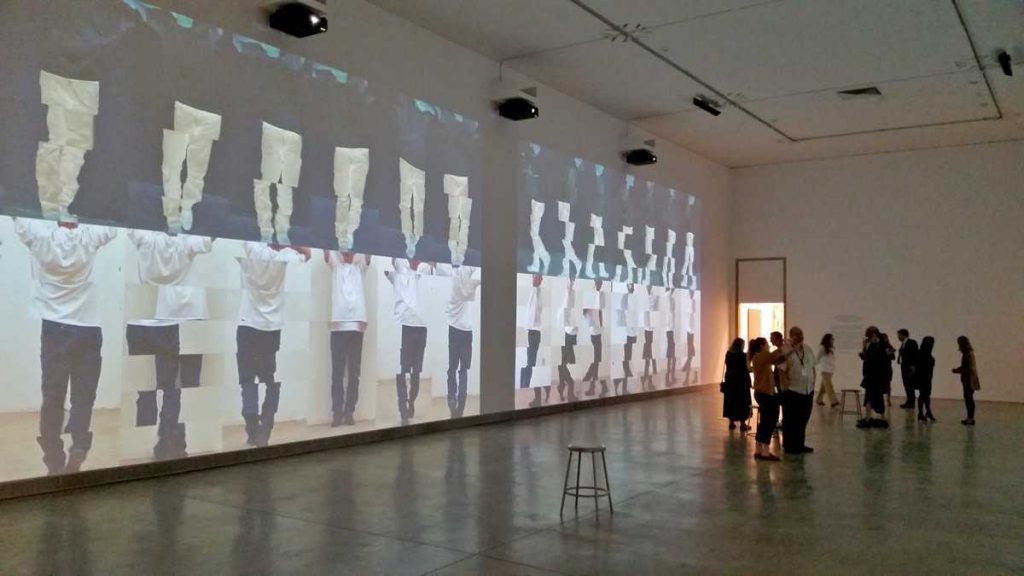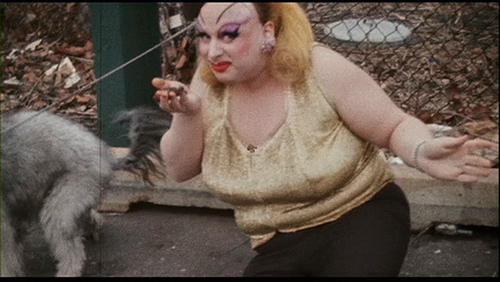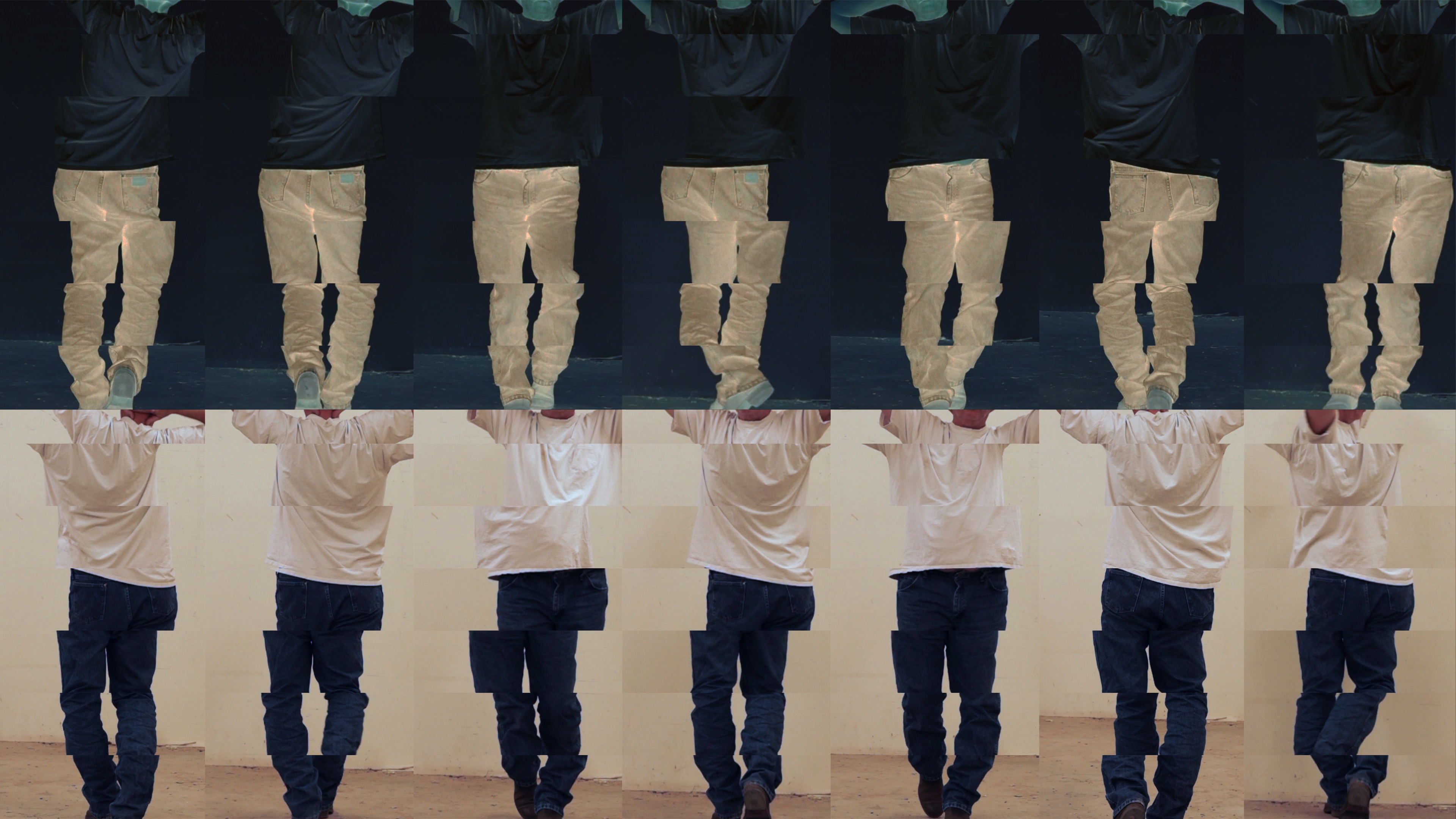Nauman and Waters Half a Century Later by Kerr Houston
“Youth is the gift of nature, but age is a work of art.” -Stanisław Jerzy Lec
What exactly is the aging famous artist – once mercurial and transgressive; now familiar and slightly slower of step – to do? How to maintain and extend a radical practice when insouciance and iconoclasm no longer feel fully appropriate, and when one’s work is already comfortably ensconced in the canon? And how, too, to acknowledge the imminence of death while honestly expressing the tired but honest wish for some sort of immortality?
Obviously, there are no simple answers to these questions. But two absorbing installations of video work currently on view – Bruce Nauman’s Contrapposto Studies, I through VII, at the Philadelphia Museum of Art, and John Waters’ Kiddie Flamingos, at the Baltimore Museum of Art – offer, in tandem, an unexpectedly productive chance to consider the theme of the aging artist. Granted, the two pieces initially seem to have little in common with each other. The fact that they are both being shown now, in such proximity, is a mere coincidence. And neither explicitly addresses the subject of old age. Nevertheless, both works represent significant re-imaginings of well-known earlier works – and thus comprise, if read closely, an affecting meditation on the passage of time.
Nauman’s studies, which represent his first major new work since 2009, take the form of seven large-scale video projections, accompanied by sound, that are screened in two airy galleries. In 1968, a twenty-something Nauman exhibited a video of himself walking through a narrow passage in an exaggerated contrapposto: his hips rising and falling in time with his carefully measured steps, he solemnly enacted a canonical classical pose. That piece is also on view in Philadelphia, on a monitor in a small room – but it’s flatly dwarfed by the monumental projections of his new work, in which the now 74-year-old Nauman walks, again in deliberate, embellished contrapposto, across the floor of his New Mexico studio.
The basic idea, then, remains constant: a half century later, Nauman is still exploring a stock pose in a manner that is at once piously reverent, archly literal, and openly deconstructive. At the same time, though, much has changed. As Carlos Basualdo, the curator who organized the show, pointed out to me, in his new work Nauman collaborated with a videographer who now maintained a constant focus on Nauman’s form: where in the earlier video work the body moves in and out of focus, it is now the subject of constant, attentive inquiry. Inquiry, but also manipulation, for the new video projections include a number of fragmented images, negatives, and reverse-motion shots. The whole is fragmented, broken down; rather as in a page of drawings by Andrea del Sarto, the integral whole gives way to the part.

And the body, we quickly realize, yields to the passage of time. In a review of the installation for the New York Times, Randy Kennedy noted that Nauman had been diagnosed with cancer in the months before filming the new work. The resulting radiation treatment caused some nerve damage that left Nauman with a temporary loss of feeling in his feet – a condition that is visible, and audible, in the occasionally heavy shuffling of his feet. But of course the less dramatic fact of simple aging plays a role, as well.
Fifty years is a long time, and its consequences are evident in the sheer heft of Nauman’s body. He wears, as he did in 1968, jeans and a white tee-shirt – but where his form was once lithe, it is now fleshy, thick, and corpulent. Yeats, in “Sailing to Byzantium,” compared an aged man to “a tattered coat upon a stick.” Nauman is certainly not that – but he is clearly growing older.
In alluding so candidly to his aging form, Nauman is in a sense typical of a broad tendency in contemporary art. As Lilly Wei observed in a 2012 ARTNews article, over the past few decades artists have addressed the theme of the aging body with increasing frequency and intensity. Dieter Roth and John Coplans, for example, regarded their stooped and ropy bodies with a dispassionate directness.
And Joan Semmel’s 2009 Triptych depicts the artist – nearly 80, but still defiantly nude – three times, in a composition that recalls both the herky-jerky qualities of a stop-motion film and the uncertain steps of an ailing senior citizen. Semmel seems to lurch, here, instead of attempting a graceful contrapposto – but, like Nauman, she too examines her motions with an intense curiosity.

Of course, an acknowledgement of age is not merely a recent development. Rembrandt, too, investigated the effects of the passage of time on his own form: over the course of his nearly one hundred self-portraits, his face becomes visibly heavier and more plastic, his nose craggier, and his flesh more pallid and loose. His two famous self-portraits in London’s National Gallery, painted in 1639 and 1669, thus offer a striking contrast.
In the earlier image, Rembrandt – rather like Nauman, centuries later – alludes to Renaissance precedent, basing his pose on earlier works by Raphael and Titian. In the later work, however, he is 63: still proud and erect, to be sure, but visibly heavier, and seemingly less playful. A jaunty interest in inserting himself into the canon has given way to a more thoughtful and severe analysis.

But what do we learn, exactly, from such an analysis? It depends. As Haim Be’er points out, in The Pure Element of Time, visitors to the National Gallery often seem to see Rembrandt’s advancing age as a remote historical abstraction, unconnected to their own lives. “People pass by and compare the two portraits,” writes Be’er, “smiling, serene in the presence of the crumbling and old age, as if the writing on the wall weren’t meant for them.”
But Nauman’s work, in this sense, is different. The fragmented forms, complex effects, amplified sound, and sheer scale of the work openly challenge us; as we stand before his work, we feel almost under assault. A few ungenerous stools, placed in the middle of the gallery, hardly offer relief: inevitably, as we spend time with Nauman’s new work, we quickly become aware of our own limits. Or, as Basualdo puts it, “it will be hard to stand in the room with it. I think it will be almost unbearable.”
Which leads us, in turn, to John Waters, whose infamous 1972 film Pink Flamingos was a gleefully irreverent exercise in extravagant bad taste whose climactic scene remains, four decades later, almost unbearable. The film focused primarily upon a purported challenge to Divine’s self-proclaimed status as ‘The Filthiest Person Alive.’
Hoping to appropriate that title, Raymond and Connie Marble execute a series of dirty tricks: mailing a turd and burning a trailer home to the ground are only part of their debased plan. In the end, however, their attempt to nab the crown is thwarted, as Divine promptly responds with a skein of outrageous deeds – culminating in the film’s notorious final sequence, which shows her daintily picking up a piece of dog shit and then eating it, simultaneously gagging and smiling at the camera.

Visitors to the BMA, however, won’t get to enjoy that grin. Instead, Waters has rewritten Pink Flamingos in a child-friendly, G-rated mode, and in his new project he records a group of kids doing a lively table reading of the new script. In several ways, the resulting 74-minute film is flatly amateurish: the children sit before a cursory backdrop and they wear only hints of costumes: a wig, or a moustache rendered in grease paint. At points, we can hear Waters offering off-screen direction, and in several quick cuts we see the child actors wriggling in their seats or openly evincing boredom as they wait for their lines.
In a sense, then, Kiddie Flamingoes is characterized by a gentle, guileless quality: these kids, as Michael Farley observed in City Paper, are adorable. And there’s a resulting temptation to see Waters’ new project as evidence of a general drift, in his later body of work, towards a surprising wholesomeness. That turn began, you might say, with Hairspray, a touching and heart-warming film; it was extended in Waters’ holiday albums, which were at once irreverent and kitschily sincere.
At first, Waters seemed to delight in the idea that such productions could surprise audiences expecting more of the depravity with which he had first made his name: “It’s great,” he once said, “to be able to shock in reverse.” But by now, the idea of Waters as potentially earnest is no longer surprising; it’s simply a fact. Despite a proud, lengthy history of crafting campy challenges to orthodox behavior, there’s a way in which he has become something like a beloved uncle: quirky, sure, but in a pleasantly colorful rather than threatening sense.
And yet the past is always with us, on some level. At one point in Filthy, Robert Pela’s genial 2002 account of Waters’ career, the director flatly observes that “My biggest competition is my past. Pink Flamingos will always be mentioned in every review of every movie I make.” Given such an idea, it’s clearly significant that Waters is now returning to the film that first made him broadly infamous. Kiddie Flamingos is thus ultimately a piece about legacy: a seemingly light-hearted but deeply rooted rumination on the arc of Waters’ own career.
Casting about for rough parallels, I thought of Marina Abramowić’s 2010 retrospective at MoMA, in which a number of her seminal performance pieces were discussed from a historical point of view and re-enacted by trained performers – presented, in other words, as part of a living, evolving history. But where that show was largely characterized by a grave, hard-edged intensity, Kiddie Flamingos suggests instead a wry and honest spirit. You might call it nostalgia with a healthy dose of self-irony.

Fascinatingly, though, it’s also a piece that openly aspires to the condition of high art. That’s implicit, first of all, in the very space in which it’s shown: projected in the BMA’s black box, Kiddie Flamingos assumes a place in a line of highly cerebral projects organized by curator Kristen Hileman. But the film’s conceptual sophistication is also evident in the way in which Waters embraces the idea that the past can never be repeated exactly. Pink Flamingos forms a constant point of reference, of course, but this new project is as interested in accident and deviation as it is in faithful reproduction.
There’s a wonderful moment, for example, when the kid reading the part of Divine unknowingly mispronounces a word: having received the turd in the mail, he responds with the mortified claim that “This is a direct attack on my Divine-ity!” That last word, we know, should be divinity, but the misreading is even richer than the original; Divine is unintentionally eulogized, here, by a child. And, in the process, Kiddie Flamingos begins to recall projects such as Jeremy Deller’s celebrated The Battle of Orgreave, a complex filmed 2001 re-creation of a violent 1984 labor dispute in which the past is enacted, but also constantly altered, by the present.
Kiddie Flamingos can be seen, then, as a bid by Waters to enter the highly conceptual terrain of contemporary art. But it can also be viewed, I think, as a provocative attempt to queer a film that was already markedly queer. Here’s what I mean: at the 48-minute mark of Pink Flamingos, Channing, a second-tier henchman, is waiting for Connie and Raymond in their home. Bored, he begins to toy with a mop head, using it as a wig, and soon falls into character, offering a lively impersonation of the couple that is simultaneously a lampoon and a light erotic fantasy.
In short, it’s a queer moment – and, when he is caught in the act by Connie and Raymond, his claim that he was merely playing hardly convinces. But now, 44 years later, we watch as the boy playing Babs also wears a ridiculous wig, and at one point brushes his false hair aside in a casually fluid, unthinking gesture. Contrived role-playing gives way, again, to something more complicated and more potentially subversive. “Can queer carry on being troublesome,” Martin Parker once wondered, in an engaging rumination on the possibility of queering queerness in the workplace, “as it moves into early middle age?” Kiddie Flamingos suggests that it certainly can – and perhaps on into old age, as well.

And so we might attempt a sort of conclusion, by means of a final parallel. In about 1724, the 75-year-old Philadelphia-based painter James Peale executed Still Life with Broken Watermelon. His choice of subject matter was notable on several levels. For one thing, it represented an emphatic return to still-life: a genre in which Peale had once excelled, but which he had largely forsaken at the height of his career, for more lucrative portraits. Rather like Nauman and Waters, then, Peale was returning in his later life to a theme that had defined him as a younger man.
In that sense, however, the shattered fruit can also be seen as significant. By crafting a variant on the vanitas theme, Peale obliquely addressed the issue of his own approaching end: bodies, too, change, and bloat, and crack. But, finally, there’s this: studied closely, the varied brushwork of Peale’s painting suggests that it was the product of a collaboration between Peale and one of his children. In his later years, then, the aging artist looked back in time, towards his earlier work, but also began to hand over some of his responsibilities to a younger generation.
Such a transition, we sense, is never entirely graceful, or frictionless. The quality of strokes may vary; the projected image may be fragmented; words may be mispronounced in the process. But perhaps it is in the frank acceptance of such difficulties and synapses that a sort of immortality resides.
*****
Author Kerr Houston has taught art history and art criticism at MICA since 2002. He is the author of the book An Introduction to Art Criticism (Pearson, 2012), and his recent writings range from an article on a metaphorical aspect of the Sistine Chapel chancel screen, in Source, to an extended essay on Candice Breitz’s Extra, in Nka.
Bruce Nauman’s Contrapposto Studies, I through VII, is on exhibit at the Philadelphia Museum of Art through January 8, 2017.
John Waters’ Kiddie Flamingos will be on exhibit at the Baltimore Museum of Art through January 22, 2017.






